Introduction
The economic situation of the rural municipalities as the smallest local government units is determined by a number of internal and external factors. The most important ones include: access to natural resources, degree of the economic progression, unemployment rate and environmental values. While defining the term ‘local development’, it should be emphasised that it is the process of positive changes, both quantitative and qualitative ones, in a specific time. Milán-García et al (2019) and Wojtasiewicz (1996) studied that the local development when the actions were taken by the local community, local authorities and entities located in the area of the given municipality is characterised by full harmony and regularity, while the trend in the conduct of these entities is useful for the municipality through creating new solutions and improving the existing utility values as well as creating spatial and ecological orderliness. As Amin (1999) mentioned, over the past few years, the concept of local development has evolved by introducing the concept of Sustainable Local Development (SLD). Mebratu (1998) confirmed that the SLD must have the capacity to maintain itself over time, respecting the limitations of the surrounding natural environment. Additionally, according to Malizia et al (1999), a public administration should support particularly
a weak economic growth.
Sztando (2002) and Tuziak (2006) mentioned that a special role in the economic development of a municipality is assigned to its authorities since they have the funds at their disposal and distribute them for specific purposes, including investment. The function of the local government authorities comes down to the integration and coordination of the local development with consideration, inter alia, of the relations and relationships occurring in the development process. Parysek (2001) studied that an impressive impact of the authorities on development also raises the interest of the local community, which is aware of the legitimacy of the performed changes, and sees the general social benefits. However, in order for development to be noticeable, proper pools of funds should be invested in realisation of specific objectives. As resulted from Herbst’s (2012) studies, in order to improve their material & living situation, the inhabitants of the local communities go abroad in masses, where they often stay for a couple of years.
Additionally, Marciniuk-Kluska (2010) analyzed that the process of Poland’s entry to the structures of the European Union has created a chance for improving the conditions of the social and local economy. The EU membership generates a positive incentive mainly in the context of the generally accepted development of rural regions. Małecki (2009) described a chance for the reasonable use of additional funds in relation to the implementation of EU programmes. A reasonable manner of spending the funds by the municipality authorities contributes to the initiation of positive economic changes in the region, which is mainly displayed in the creation of development, improvement of management profitability and improvement of social sentiments. Broll (2008) noticed that social capital plays a crucial role in every municipality, driving the widely-understood development in the given region.
Szlaska (2007) listed numerous important functions that should be performed by the municipal local government for local development, including: initiation, coordination, supporting and assessment of the social & economic development of the municipality. As a result from the studies performed so far, there are a couple of perspective directions of development of mountain municipalities:
- Development of cross-border cooperation,
- Construction of roads within inter-municipal initiatives,
- Development of touristic and health-resort functions,
- Increase of investments from outside,
- Possibility of obtaining more funds for investments from the central level and special-purpose subsidies,
- Development of agritourism.
In mountain regions, tourism takes on a very important role as a strategy for local development. Cunha (2005) mentioned that tourism is a sector that favours local development because it generates jobs, increases the income of workers and stimulates capital investments through new business opportunities.
The purpose of this article is to analyse the municipal resources and the potential chances for improving the social & economic situation of the selected mountain municipalities, being similar in terms of the number of inhabitants and the amount of the annual budget. The results of this analysis will lead to indicate the municipality’s areas of economy which, from the economic point of view, seem to be the most perspective, since those municipalities will affect further development of the region.
Material and Methodology
In order to analyse the chances and prospects for development, a survey was conducted among the inhabitants of the described municipalities. The studies were performed among 200 inhabitants of mountain municipalities, including farmers. A survey consisting of 10 questions (6 open and 4 closed ones) was used in the studies. Additionally, several questions were addressed to 100 tourists coming during summer holidays, in order for them to assess the level of attractiveness of the region from their own perspective. An assessment of the impact of the natural environment on the life quality of the inhabitants of that region was performed. In the field of agritourism and agriculture, an assessment of the safety of work in the area of the examined municipalities was performed.
The quality of the environment in the analysed communes was assessed on the basis of an analysis of the land use plan of the communes, ecophysiographic studies and a review of thematic maps, such as soil maps, hydrological maps, climate maps, etc.
In order to analyse the quality of the natural environment and landscape values a multidimensional statistical analysis was applied – the Zero Unitarization Method (Kukuła 2000). This method requires that all assessment indicators (diagnostic variables) are given dimensionless numerical values. For this purpose, the assessment indicators were divided into two groups: stimulants and destimulants.
A stimulant is such a diagnostic variable of which increase should be associated with an increase in the assessment of environmental quality and landscape values, while its decrease is associated with a decrease of environmental quality and landscape values. These variables were normalised according to the formula of Kukuła et al (2014):

A destimulant is a diagnostic variable increase of which should be associated with a decrease in the assessment of environmental quality and landscape values, while its decrease is associated with an increase of environmental quality and landscape values.. Destimulants were normalised according to the formula:

In these formulas:
i – number of the commune,
j – number of the diagnostic variable,
zij – normalised variable,
xij – variable prior to normalisation,
max xij – maximum value of the variable in a given set,
min xij – minimum value of the variable in a given set.
Table 1 presents the analysed environmental parameters which are the assessment indicators, as well as their division into stimulants and destimulants. These indicators characterise basic elements of the environment, such as: topography, climate, air, surface and underground waters, soils, and animated nature.
Table 1: Indicators for assessing environmental quality and landscape values

The analysis assumes that all the assessment criteria are equally weighted. Indicators concerning the number of objects subject to protection were compared to the total area of the commune. The sum of values of standardised zij variables for the communes, referred to as aggregated variable Q, was the basis for selecting the commune with a higher quality of environment and higher landscape values. The higher the value of variable Q, the higher the environmental quality assessment.
The assessment made on the basis of a multi-criteria analysis was compared with the survey’s results of the assessment of the impact of the natural environment on the quality of life in the communes .
The statistical Student t-test was carried out to determine the significance of the differences among the financial expenditures in both municipalities.
Results
The number of inhabitants of the examined municipalities was around 20 thousand persons. Population density of these municipalities was 56 persons per 1 km2 for municipality A and 60 persons for municipality B. The area of the described municipalities includes not only places with a relatively high population rate but also significantly depopulated ones. The drop of the population number is entailed by the decreasing rate of birthrate as well as by the negative balance of population migration. The negative demographic phenomena significantly affect the economic situation of the municipalities, hindering their systematic development and improvement of the level of living.
Numerous tourists, pedestrians and bicycle routes, including two transit ones, running along the Sudeten Mountains and constituting the main tourist axes of the municipalities, run through the area of the described regions. This is why they are so significant in social & economic terms. This is also connected with the development of tourism and agriatourism, which enhances the attractiveness and image of the municipalities.
For the purposes of the article, the structure of expenditures of the selected municipalities was analysed as well – Table 2. The percentage distribution of the incurred expenditures of municipality A in comparison with rural municipality B was presented. It results from the analysis that the greatest percentage was designated for education and upbringing – 22.4% and 35.8% respectively. Expenditures on the provision of social aid constituted a significant part as well. Almost 1% of the expenditures constituted the financial support for health protection in both municipalities.
Table 2: Percentage distribution of expenditure in the budget of the A community
and B community
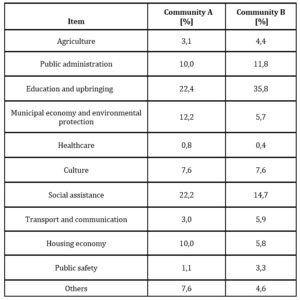
Among the surveyed inhabitants, the vast majority is convinced of staying in their current place of residence, and at the same time caring about development and improving their region’s economic level mainly through the establishment of own business activity. Almost 30% of the inhabitants are uncertain about their future, while 10% of the respondents plan to travel abroad in the nearest future to look for a better job. The statistical test results showed that the differences in expenditures in both compared communities are not statistically significant (p-value = 0,44).
The role of the municipality authorities, the priority of which should be caring about properly satisfying the needs of the population living there in order to limit the economic migration to a significant extent. It is mainly displayed in the aspect of social activation through granting tax reliefs for newly-established undertakings. It is worth referring to the main function of the local social capital which is widely described by Matysiak (1999), namely the reduction of uncertainty, both in social life and in economic life, upon deciding on conducting a business activity, as well as the cooperation between the local community and the local government authorities. The effects of a proper use of the social capital may lead to increasing the trust of the society towards the authorities as well as to the support of the widely-understood public & private partnership.
Consequently, an effective policy of the authorities of the described municipality may significantly improve its competitiveness. Resulting from the developed data, agriculture and low level of activity of the inhabitants of the municipality have the weakest impact on improvement in this aspect. The majority of the respondents who were asked about the strengths of the municipality which they lived in, indicated its good geographic location (35%). A bit fewer respondents, i.e. 21%, indicated attractive investment areas as a factor enhancing the competitiveness of the municipality. Among the most developmental directions of economy in municipality A, the inhabitants put first tourism and agritourism (41 responses), then industrial production (14 persons) and services (24 respondents), as shown in Figure 1. On the other hand, in municipality B, most persons indicated convenient conditions for the development of agritourism (39 persons) and agricultural production (20 persons).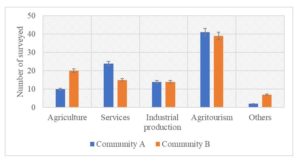
Fig. 1: The most perspective sectors of the economy in community A and community B from their residents’ assessment.
Also, the work of the local Municipality Offices, labour work and condition of the natural environment were subjected to assessment from the inhabitants. As for the local community, 65% of the inhabitants assess the functioning labour market as very bad, while only 31% are satisfied with it. The natural environment is assessed very well by 13% of the respondents, while the work of the Municipality Office is perceived as good by 64% of the respondents. In municipality B, 40% of the respondents assess the work of the municipal officials as good and 38% perceive the condition of the natural environment as good. On the other hand, there were very bad opinions related to the local labour market regarding the lack of job opportunities in the municipality, which makes the inhabitants travel to work to the near Czech Republic.
As a part of the studies, the tourists arrived in the municipality were also asked
a question. Figure 2 presents the most important values in the tourists’ opinions, which significantly intensify the tourist traffic in the region. The results from this data show that it is mainly the gastronomic base and the natural values that attract tourists to municipality A the most.
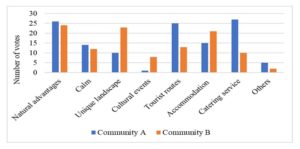
Fig. 2: Distribution of answers to the question: What is the most attractive values for tourists in researched communities?
For 14 tourists, it is tranquillity that decides on the unique character of the place, while for 26 tourists, these are touristic attractions. It is also known that there are cultural events organised in the municipality, yet their impact on promoting the region is minor. It is similarly in municipality B, where additionally, the accommodation facilities and the unique landscape encourage tourists to visit this region.
The studies attempted to identify the problems faced by the inhabitants of the municipalities. As it turned out, the most important ones include: unemployment (25 inhabitants), damaged roads (17) and lack of proper support for entrepreneurship (35). The obtained results are presented in Figure 3.
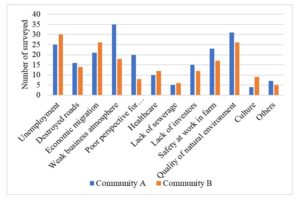
Fig. 3: Current problems identified in the communities according to their residents (number of persons).
Among the problems of the inhabitants determined in Figure 3, the level of natural environment quality and the level of the safety of work were selected for the purposes of assessing the impact of the specified areas on the level of life quality of the inhabitants of those municipalities.
Natural Environment Quality
The results of the quality natural environment assessment are presented below. Table 3 shows the values of the analysed environmental parameters.
Table 3: Values of the environmental variables considered in the analysis
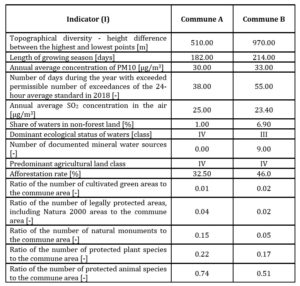
Table 3 shows that commune B is characterised by a more diversified topography, warmer climate, denser hydrographic network, better water quality and higher afforestation rate. In addition, there are mineral water deposits in commune B. Due to this, as well as to specific climatic conditions, spa areas are located in this commune. In comparison with commune A, commune B is characterised by a higher concentration of PM10 and a much higher number of days of exceeding the permissible concentrations. Both communes are dominated by weak soils, belonging to the IV agricultural land class. The number of protected areas and objects in relation to the total area of the communes is also similar.
Table 4 presents the results of the assessment of environmental quality and landscape values in both communes on the basis of a multi-criteria analysis.
Table 4: Environmental quality (Q) based on the results of a multi-criteria analysis

The multi-criteria analysis showed that commune B is characterised by a higher quality of environment and higher landscape values than commune A. Similarly, the natural environment was assessed by the inhabitants of both communes. In commune A, only 13% of the inhabitants rated the quality of the environment as good, while in commune B, 38% of the inhabitants voted the same. This demonstrates a high level of public awareness as regards to the environmental protection and the ability to correctly assess the quality of the environment.
Environmental quality and landscape values have a huge impact on the quality of people’s lives, as well as on the development of tourism, as evidenced by the results of a survey conducted among tourists visiting both communes. Human beings use the environment and at the same time they interact with it, which has extensive and complex consequences. Anthropo-pressure causes the transformation or contamination of all the inanimate elements of the environment, such as air, water and soil, climate change, biological impoverishment, changes in the landscape or a decrease in the productivity of ecosystems. According to Dobrzański et al (2000), these direct effects cause economic losses (e.g. in industry, agriculture, forestry, fishing), worsening of working and leisure conditions, deterioration of health and living comfort, as well as a number of other intangible effects. Environmental threats are associated with diseases, defined as environmental or civilisation-related. These include cancer and cardiovascular diseases, respiratory and nervous system disorders, immune system damage and allergies. It is therefore necessary to take measures to improve the quality of the environment.
Since the greatest problem in both communes is unsatisfactory air quality, especially during the heating season, and unregulated wastewater management, which affects the condition of the surface water, these aspects should be included in the communes’ action programmes as priorities. Both communes are characterised by high natural landscape values and have great potential for tourism development. It should therefore be supported by investing in tourism infrastructure, increasing accommodation offers and catering facilities, as well as promoting the communes.
Safety at work
In the area of the safety of work, an assessment of the physical burdens in the musculoskeletal system of the inhabitants of the municipalities was performed. During the studies, the respondents were asked about the intensity and frequency of the occurrence of ailments and discomfort in connection with the performed professional work. The results of the studies are presented in Figure 4.

Fig. 4: Pain and discomfort appeared among workers in their musculoskeletal system.
Among the numerous places in the musculoskeletal system, in which the pain centres were reported in the examined group, from time to time (once/twice a week) pain in the lumbar part of the spine, in the neck area and in the shoulder line occurred. Headaches and forearm pain were suffered very sporadically – a couple of times a month, and as it was argued, such conditions occurred after a long-term engagement of hands, e.g. as a result of the accumulation of the performed works. In case of continuous pain suffering, there is a high risk of the occurrence of durable ailments, including in particular, joint degeneration, limb numbness and greater vulnerability to injuries. Consequently, it leads to absence from work and in extreme cases – to rehabilitation and significant financial outlays on health improvement.
Summary
While analysing the social & economic situation of the described municipalities, it should be emphasised that the condition of the majority of the economic sectors of these units is satisfactory, yet there are some prerequisites for improving their conditions. Due to orographic conditions, agriculture is not a perspective direction of development, similarly to industry due to lack of mineral raw materials. Both inhabitants and tourists indicate the great touristic potential of both communes, resulting from their location and environmental values. Both municipalities are located in the submontane area, in the macro-region of the Central Sudetes. Diverse terrain relief and a relatively large afforestation rate make those areas very attractive. The assessment of the quality of the environment by inhabitants was confirmed by the results of a multi-criteria analysis. This demonstrates a high level of public awareness as regards to the environmental protection and the ability to correctly assess the quality of the environment. Environmental quality and landscape values have a huge impact on the quality of people’s lives, as well as on the development of tourism, especially agritourism. Despite this, in both communes, insufficient funds are allocated for environmental protection, investing in tourism infrastructure, increasing the accommodation offers and catering facilities, as well as promoting the communes. Investments in these areas would contribute to reducing unemployment, which was recognized as one of the major problems in both municipalities. Actually, almost 30% of the surveyed inhabitants are uncertain about their future, while 10% of the respondents plan to travel abroad to look for a better job.
The development of agritourism is associated with the problem of safety at work in farms. The respondents indicated that this is an important problem in both municipalities. Based on the research, it was found that employees in farms mainly suffer from pain in the lumbar part of the spine, in the neck area and in the shoulder line and pain of legs. So far, only less than 1% of the expenditures constituted financial support for health protection in both municipalities. Therefore, along with the development of agritourism, expenditure on health protection and improvement of working conditions in the agriculture and agritourism sector should be increased.
The development of tourism can also have negative impacts on the environment and health of the local community. It results in water and air pollution, noise, invasion of protected areas, etc.
Analysing the economic situation in a cross-sectional way, the occurring developmental barriers together with the possibilities, and the needs to make a lot of infrastructural investments which would contribute to improving the social & economic situation should be noticed.
(adsbygoogle = window.adsbygoogle || []).push({});
References
- Amin, A. (1999). ‘An institutionalist perspective on regional economic development,’ International Journal Urban Reg. Res. 23, 365–378.
- Broll, R. (1998). ‘Local development management – case study,’ Wroclaw University of Economics , Wrocław, 1-5.
- Cunha, SK. and Cunha, JC. (2005). ‘Tourism cluster competitiveness and sustainability: proposal for a systemic model to measure the impact of tourism on local development,’ BAR – Brazilian Administration Review, 2 (2), 47-62.
- Dobrzański, G., Dobrzańska, B. and Kiełczewski, D. (2008). ‘Environmental protection,’ PWN Scientific Publishing House, Warszawa, 460.
- Herbst, M. (2012). ‘Education as a factor and result of regional development,’ SCHOLAR Publishing House, Warszawa, 167–194.
- Kukuła, K. (2000). ‘Zero unitarization method,’ PWN Scientific Publishing House, Warszawa.
- Kukuła, K. and Bogocz, D. (2014). ‘Zero Unitarization Method and its application in ranking research in agriculture,’ Economic and Regional Studies, 7(3), 5–13.
- Malizia, EE. and Feser, EJ. (1999). ‘Understanding Local Economic Development,’ Rutgers, NJ: Center for Urban Policy Research.
- Małecki, P. (2009). ‘EU subsidies, subsidies and other surcharges in the goods and services tax,’ Human Resources Consulting and Improvement Center, Gdańsk, 6.
- Marciniuk – Kluska, A. and Bombik, A. (2010). ‘An attempt to assess the development of the Polish countryside five years after joining the European Union,’ Studia Ecologiae et Bioethicae 8(1), 15-20.
- Matysiak, A. (1999). ‘Sources of social capital.’ Wroclaw University of Economics, Wrocław.
- Mebratu, D. (1998). ‘Sustainability and sustainable development: Historical and conceptual review,’ Impact Asses. 18, 493–520.
- Milán-García, J., Uribe-Toril, J., Ruiz-Real, JL. and Valenciano, J. (2019). ‘Sustainable Local Development’: An Overview of the State of Knowledge. Resources, 8, 31.
- Parysek, J. (2001). ‘Basics of local economy’, University of Warsaw of Adam Mickiewicz, Poznań, 46-51.
- Szlaska, A. (2007). ‘Commune development strategies as a determinant of the approach of the local political elite to local development,’ SriL, Warszawa,121.
- Sztando, A. (2002). ‘Criteria of local interventionism on the example of selected communes [in:] Entrepreneurship and innovation as a factor of regional and local development,’ Włocławek Scientific Society in Włocławek , 2-9.
- Tuziak, A. (2006). ‘Social capital of local self-government communities [in:] Social inequalities and economic growth. Human and intellectual capital,’ University of Rzeszów, 137-147.
- Wojtasiewicz, L. (1996). ‘Factors and barriers to local development in the current economic policy of Poland. [in]: Local economy in theory and in practice,’ Wrocław University of Economics, 734, 14.












